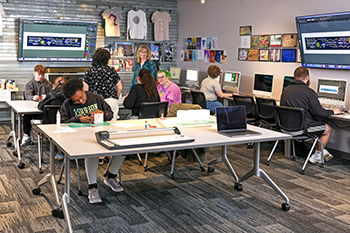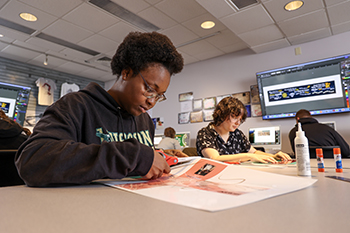
Technology, Creativity, Collaboration: How NESCOM's Graphic / Visual Design Classes Prepare Students for Success
Published on: July 10, 2024

Technology is always evolving, but good design is good design. Many college graphic design programs tend to focus on either the technological or the creative, but Husson University's Graphic / Visual Design degree program – offered as part of the New England School of Communications (NESCom) – gives students a strong foundation of knowledge and skill in both technology and design fundamentals.
It's an approach championed by Theresa Ayotte, Assistant Professor of Graphic / Visual Design, who helped to develop and oversees the program. "I have been a professional designer for over 30 years. Just in my own career, graphic design has evolved from hand cutting and pasting designs together to being able to completely create designs on the computer," she explains. "Technology is simply a tool in the toolbox. It's the creativity that is the true skill behind the greatest design."
In the Graphic / Visual Design classes — a requirement for all NESCom students — Ayotte combines an open-minded approach to using technology with classic design and creative principles, and infuses it with a practical and real-world experience perspective and skill-building. As a result, the program produces graduates who are lifetime learners with an adaptable skillset that can be applied to a range of careers.
Here's how it works.
Technology
"Our program is not just graphic design, it's Graphic / Visual Design. We aren't just looking at logos and designs, but also data visualization, user experience, design for augmented and virtual reality and all of these areas that graphic designers are going into currently and in the future." explains Ayotte. "Many programs for graphic design are housed within the art department of schools. Often, that means there's a large art component, where students also have to take drawing, painting, ceramics and sculpture. At Husson, we bridge the idea of traditional graphic design with technology. It's a very forward-thinking curriculum."
That means Husson students are not only working with up-to-date technology and design tools like Adobe InDesign and Photoshop, but that they are also designing for cutting-edge technology. "Students today, without a doubt, are going to be encountering in their careers areas like augmented and virtual reality," she says. Husson students can even pursue certifications in specialized areas like User Experience (UX) Design and 3D Modeling and Motion Design.
Another important aspect of Ayotte's approach is maintaining an open mind towards new tools and technologies. Artificial intelligence (AI) is one recent example. While some of her students are wary of using generative AIs, Ayotte views them as a tool, and encourages students to think of them almost like another collaborator. She explains "I encourage students who are having trouble finding a particular image or inspiration to see what generative AI will create for them. Or they can use AI like a fellow classmate to get feedback, or try different prompts to get new ideas."
It all comes back to understanding that technology is ultimately a tool to help in the creative process. "Some technologies come and some go — until something better comes along. A technology we may not have much use for now may become the standard in a few years. As designers, we must be open to all new technologies," Ayotte says. "Many students begin intimidated by all the software we use. But after they learn and understand that it's just a tool, much like a pencil or paintbrush, to express their creativity, they view it differently."
Creativity
That focus on creativity is the other key part of Ayotte's teaching and Husson's Graphic / Visual Design program. "Everybody's creative," she says. "In my class, we pull that creativity out of you."
To do so, Ayotte puts a strong focus on the fundamentals of design and collaboration, an approach that takes some more tech-oriented students by surprise. "I see it a lot, especially with new students, where they will focus on the technology and what they can do with it, rather than thinking about the design itself first."
 To put her students in the right creative headspace, Ayotte frequently begins with what she calls "basic design principles." She explains, "These have been around for 75 years, and are about learning how to balance your design, how to create unity within your design, how to work with color. Even font choices can play on how your audience feels."
To put her students in the right creative headspace, Ayotte frequently begins with what she calls "basic design principles." She explains, "These have been around for 75 years, and are about learning how to balance your design, how to create unity within your design, how to work with color. Even font choices can play on how your audience feels."
Ayotte supplements this focus on the principles of design by also having her students do plenty of research. "We look through the history of graphic design and analyze the work of very famous designers," she says. "We have a logo design project, for example, and student have to make up their own business and design a logo for it. I'll have them research logos for similar businesses, see what's been done before. A lot of it's pretty obvious, so I tell them I don't want to see anything that's been done before. I want you to do something different. It's when you go beyond the obvious that creativity kicks in."
Finally, though the students will typically complete their designs using software and technology, Ayotte has them start the old fashioned way: with a paper and a pen or pencil. "As part of the creative process, students have to hand sketch their initial designs. I can tell a lot from a simple hand sketch, and either keep pushing them forward or lead them in different directions before they dive into the technology too much."
Collaboration
A willingness to make changes and embrace different directions is one of the most essential skills Ayotte teaches her students. "I encourage change. I don't mind them getting halfway through a project or even the critique stage, and having a student say 'oh this didn't work, I'm starting over.' Sometimes you have to go down a less successful path to find the right path, and being able to turn back and start over is an important part of the process."
 Ayotte points to her own history as a designer for why she values change so much. "As a professional designer, I've often gotten clients who have left difficult designers and come to me, because the other designer won't budge on an idea. That's just not the way it needs to work. You're not designing for yourself, you're designing for an end user or client. More importantly, I've never hit a design out of the ballpark the first time. The give and take and back and forth with others, whether it's your peers or a client, always make the design stronger."
Ayotte points to her own history as a designer for why she values change so much. "As a professional designer, I've often gotten clients who have left difficult designers and come to me, because the other designer won't budge on an idea. That's just not the way it needs to work. You're not designing for yourself, you're designing for an end user or client. More importantly, I've never hit a design out of the ballpark the first time. The give and take and back and forth with others, whether it's your peers or a client, always make the design stronger."
To that end, collaboration is a key part of the Graphic / Visual Design program, as students are encouraged to work together and share feedback in class. This not only strengthens the designs, but helps students build interpersonal, collaborative skills that are a must in any professional setting. Students even get to put those skills to the test at One Circle Agency, a university-owned, student-run full-service marketing agency. Real clients work with the agency, with students taking on professional roles. In doing so, they learn how to communicate with clients, accept feedback, defend their work, and ultimately deliver work that truly meets their clients' needs.
For Ayotte, those professional skills, coupled with the creative fundamentals she teaches in class, are why she doesn't feel that any technology like generative AI will ever replace designers and the work they do. She says, "With so much content being generated out there, the targeted and knowledgeable approach a professional designer brings in distinguishing their clients above others is more important than ever."
Become a Graphic Design Professional at Husson and NESCOM
Ready to begin your journey toward a career in marketing and design? Whether you're more technologically oriented or a passionate artist, Husson's Graphic / Visual Design program offers a balanced education that will help you build both a set of skills as well and a professional approach to collaboration and the creative process.
Learn more about NESCom and this program by requesting more info, then apply to Husson today!
Back to All Articles